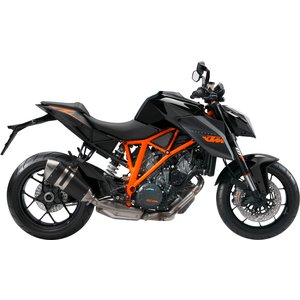KTM 1290 Super Duke GT (2014–2016): The Beast Goes Touring
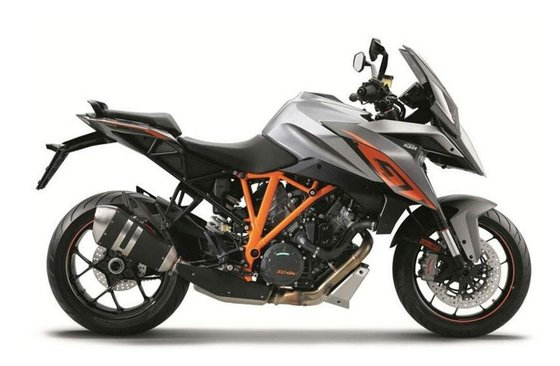
Introduction
The KTM 1290 Super Duke GT is not a motorcycle that asks for permission. It doesn’t tiptoe into the sport-touring segment—it kicks down the door with a 1301cc V-twin roar, daring riders to redefine what a touring machine can be. Built on the bones of the infamous “Beast” (the 1290 Super Duke R), the GT variant takes KTM’s “Ready to Race” ethos and injects it with a dose of practicality, transforming raw aggression into a refined, continent-crushing weapon.
From 2014 to 2016, this generation of the Super Duke GT reigned as KTM’s answer to riders who refused to choose between adrenaline and endurance. With 173 hp, semi-active suspension, and a tech suite borrowed from MotoGP, it’s a motorcycle that laughs at compromises. I recently spent time with a 2016 model, and here’s why it left me equal parts exhilarated and astonished.
Design & Ergonomics: Touring, But Make It Aggressive
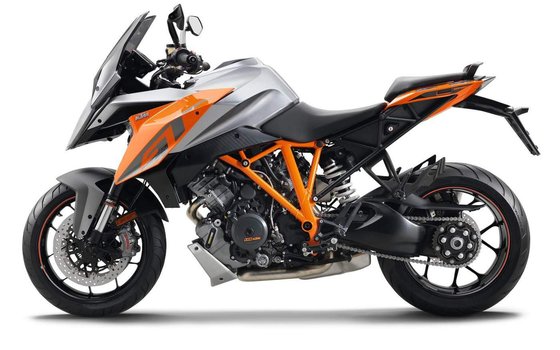
Visual Presence
The Super Duke GT doesn’t hide its intentions. Its angular fuel tank, exposed trellis frame, and sharp LED headlights scream performance. The orange-and-silver livery is pure KTM—loud, proud, and impossible to ignore. Yet, subtle touring touches like the adjustable windshield and integrated pannier mounts hint at its dual personality.
Riding Position
At 835 mm (32.9 in), the seat height is tall but manageable for riders over 5’8”. The ergonomics strike a clever balance: the bars are slightly raised for comfort, while the footpegs sit lower than the Super Duke R’s, offering a relaxed knee bend. After 400 km in the saddle, my back and wrists still felt fresh—a testament to KTM’s focus on long-haul usability.
Practical Touches
- 23L Fuel Tank: Provides 350–400 km of range, depending on how hard you exploit the 173 hp.
- Adjustable Windshield: A one-handed lever lets you tweak airflow from a full tuck to upright cruising.
- Heated Grips: A lifesaver in chilly mountain passes, with three heat settings.
Performance: Controlled Chaos
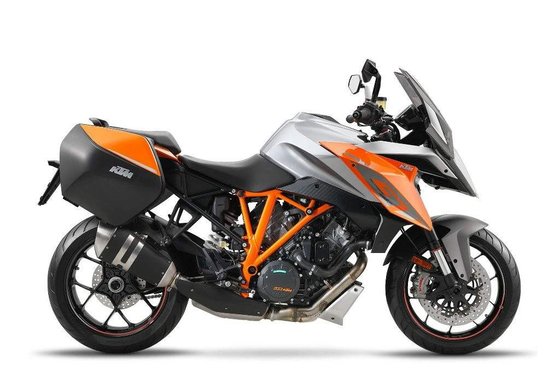
Engine & Power Delivery
The 75° V-twin is a masterpiece. With 144 Nm (106 lb-ft) of torque available as low as 3,250 rpm, the GT lunges forward like a freight train, yet remains butter-smooth at highway speeds. The ride-by-wire throttle serves up three modes:
- Rain: Tames power to 100 hp, ideal for slippery roads.
- Street: 140 hp with progressive throttle response.
- Sport: Unleashes the full 173 hp, paired with razor-sharp reflexes.
In Sport mode, the GT devours corners. The quickshifter (standard) allows clutchless upshifts, while the PASC slipper clutch prevents rear-wheel hop during aggressive downshifts.
Chassis & Handling
The chrome-moly steel trellis frame and WP semi-active suspension transform the GT from a relaxed tourer to a canyon carver at the push of a button. Three damping modes adjust in real-time:
- Comfort: Soaks up potholes for all-day rides.
- Street: Balanced for mixed conditions.
- Sport: Firms up for track-like precision.
With a wheelbase of 1,482 mm (58.3 in) and a lean angle-sensitive ABS, the GT feels planted mid-corner yet flickable enough to embarrass smaller bikes.
Braking
Brembo M50 calipers bite dual 320 mm discs up front, offering surgical stopping power. The ABS intervenes subtly, even at extreme lean angles. For hooligans, Supermoto mode disables rear ABS for smoky slides.
Electronics & Safety: Smarter Than Your Average Beast
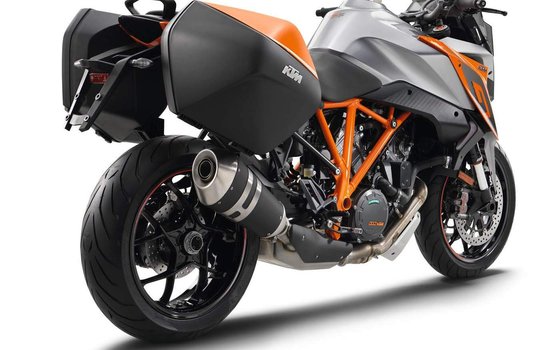
Motorcycle Stability Control (MSC)
KTM’s Bosch-derived MSC suite includes:
- Cornering ABS: Adjusts braking force based on lean angle.
- Motor Traction Control (MTC): Nine levels of slip adjustment, from rain-safe to drift-happy.
- Motor Slip Regulation (MSR): Prevents rear-wheel lock on abrupt throttle cuts.
Touring Tech
- Cruise Control: Effortlessly holds speed on highways.
- LED Cornering Lights: Illuminate bends like a spotlight, adapting to lean angle.
- Tire Pressure Monitoring: Alerts you before a flat ruins your ride.
Competition: How the GT Stacks Up
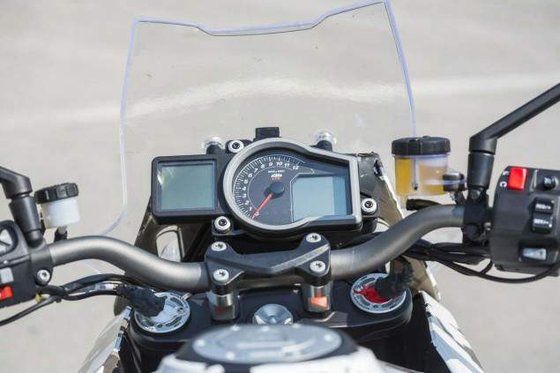
BMW S1000XR
- Pros: Smoother inline-four engine, optional Dynamic ESA.
- Cons: 215 kg (474 lbs) wet weight; feels portly compared to the GT’s 228 kg (506 lbs).
- Verdict: The XR is tech-heavy but lacks the GT’s visceral thrill.
Ducati Multistrada 1260
- Pros: Glorious V4 engine, Skyhook suspension.
- Cons: Higher seat (840–860 mm), pricier maintenance.
- Verdict: Better for luxury touring; the GT dominates in agility.
Yamaha FJR1300
- Pros: Plush saddle, shaft drive.
- Cons: Antiquated suspension, 289 kg (637 lbs) curb weight.
- Verdict: The FJR is a couch—the GT is a scalpel.
Maintenance: Keeping the Beast Healthy
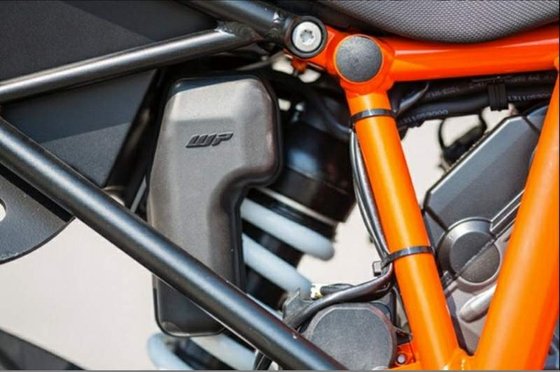
Key Service Points
- Valve Clearances: Check every 15,000 km (9,300 mi).
- Intake: 0.10–0.15 mm (0.004–0.006 in)
- Exhaust: 0.25–0.30 mm (0.010–0.012 in)
- Oil Changes: Use JASO MA-rated 10W-50 or 5W-40 synthetic. Capacity: 3.5L with filter.
- Chain Care: Lubricate every 500 km (310 mi). Adjust tension to 50–55 mm (2.0–2.2 in).
- Brake Fluid: Replace DOT 4/5.1 fluid every 2 years.
- Coolant: Flush every 4 years or 40,000 km (24,800 mi).
MOTOPARTS.store Recommendations
- Air Filters: Upgrade to a high-flow kit for sharper throttle response.
- Brake Pads: Swap to sintered pads for track-day readiness.
- Suspension Upgrades: WP PRO components for riders seeking personalized damping.
Conclusion
The KTM 1290 Super Duke GT is a paradox—a gentleman’s hooligan. It’s as comfortable carving Alpine passes as it is cruising to a coffee shop, all while daring you to misbehave. For riders who want a touring bike that refuses to grow up, the GT is peerless. And when it’s time to tweak, upgrade, or maintain your Beast, MOTOPARTS.store has the expertise and parts to keep it biting at the bit.
Specifications sheet
| Engine | |
|---|---|
| Stroke: | Four-stroke |
| Max power: | 127 kW | 170.0 hp |
| Max torque: | 144 Nm |
| Fuel system: | Keihin EFI, throttle body 56 mm |
| Max power @: | 9500 rpm |
| Displacement: | 1301 ccm |
| Bore x stroke: | 108 x 71 mm (4.3 x 2.8 in) |
| Configuration: | V |
| Cooling system: | Liquid cooling |
| Compression ratio: | 13.2:1 |
| Number of cylinders: | 2 |
| Dimensions | |
|---|---|
| Wheelbase: | 1482 mm (58.3 in) |
| Dry weight: | 212 |
| Wet weight: | 228 |
| Seat height: | 835 mm (32.9 in) |
| Ground clearance: | 140 mm (5.5 in) |
| Fuel tank capacity: | 23 L (6.1 US gal) |
| Drivetrain | |
|---|---|
| Clutch: | PASC slipper, hydraulically operated |
| Final drive: | chain |
| Transmission: | 6-speed |
| Rear sprocket: | 38 |
| Front sprocket: | 17 |
| Electronics | |
|---|---|
| Dashboard: | VDO instrument cluster with TFT display |
| Rider aids: | MSC with Cornering ABS, MTC traction control, Ride Modes (Rain, Street, Sport) |
| LED lighting: | Cornering lights with integrated turn signals |
| Quickshifter: | Standard |
| Cruise control: | Standard |
| Tire Pressure Monitoring System (TPMS): | Standard |
| Maintainance | |
|---|---|
| Rear tire: | 190/55 z-17 |
| Engine oil: | 10W-50 or 5W-40 |
| Front tire: | 120/70 z-17 |
| Break fluid: | DOT 4 or DOT 5.1 |
| Spark plugs: | NGK LKAR9BI-10 (front), NGK LMAR7DI-10 (rear) |
| Spark plug gap: | 1.0 |
| Coolant capacity: | 3.2 |
| Forks oil capacity: | 1.08 |
| Engine oil capacity: | 3.5 |
| Engine oil change interval: | Every 5000km or 2 years |
| Valve clearance (intake, cold): | 0.10–0.15 mm |
| Valve clearance check interval: | 24,000 km / 15,000 mi |
| Valve clearance (exhaust, cold): | 0.25–0.30 mm |
| Recommended tire pressure (rear): | 2.9 bar (42 psi) |
| Recommended tire pressure (front): | 2.5 bar (36 psi) |
| Chassis and Suspension | |
|---|---|
| Frame: | Chrome-molybdenum steel trellis |
| Rear brakes: | 240 mm single disc, 2-piston Brembo caliper, ABS |
| Front brakes: | 320 mm dual floating discs, Brembo M50 4-piston calipers, ABS |
| Rear suspension: | WP Semi-Active monoshock, single-sided swingarm |
| Steering damper: | WP adjustable steering damper |
| Front suspension: | WP Semi-Active USD fork, Ø 48 mm |
| Rear wheel travel: | 156 mm (6.1 in) |
| Front wheel travel: | 125 mm (4.9 in) |



